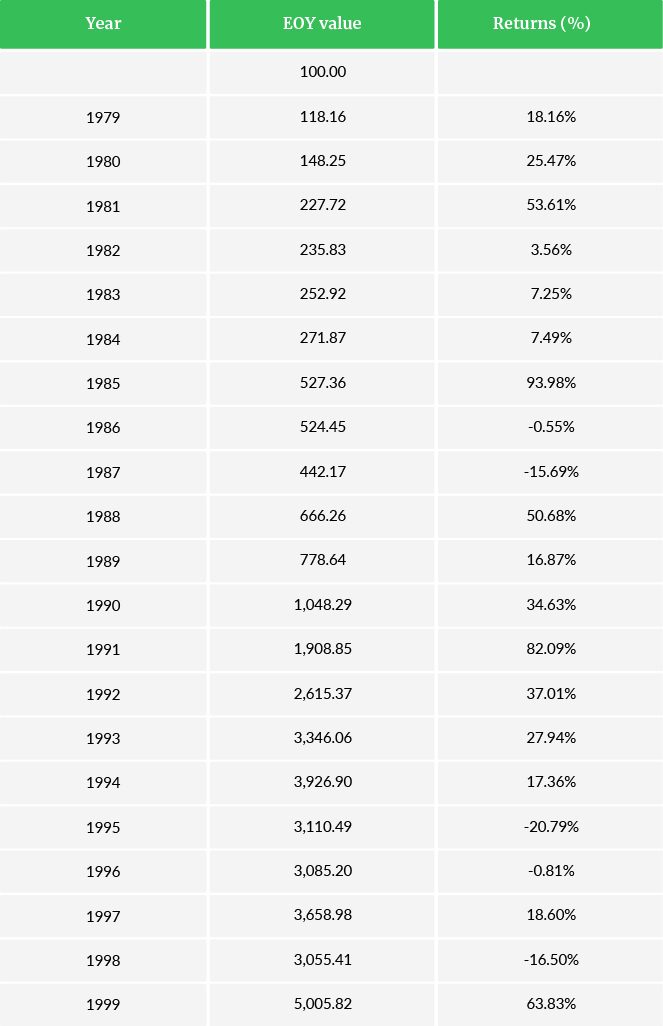Lessons from the last 40+ years of Investing
Last week, I had written a column on the Legend of Compounding and how most people never get to experience Compounding in their lives. I also wrote what you should do to experience the most powerful Wonder of the World. This week, I thought of sharing some numbers about the last 40 years of performance of the Sensex and some insights that I culled out of this data. Let me make the standard disclosure though: Past Performance is no reflection of Future Performance.
While the objective of this post is not to tout performance or to say this is how it will happen, it is to tell you that there are insights, patterns and trends that markets world over follow and we are likely to witness similar patterns and trends even in the future.
First, some data dump of the last 42 years of Sensex performance (every year from 1979 – 2020). The table shows the calendar year, the corresponding Sensex level at the end of the year and the performance for the year. Though 2020 is not yet done, I am still assuming it as a negative year (though no one knows how it will end).


The compounded Annual growth rate of the Sensex from April 1979 till date is 15.41%.
Look at this table carefully.
What do you really see? I want you to go over the data again. This is what I could see, think, and analyse. I have analysed this in multiple ways and can write an entire volume on this with different permutations and combinations. However, I simplified the key learnings that are essential for you to leave compounding alone (Sorry but this is so important that you might find me repeating this leave compounding alone mantra several times).
- There are only 4 years where the performance is within 2% of the average of 15.41%. This means performance between 13.41% and 17.41%. This is 9.5% of the time only. There are only 7 years overall where the performance is within 3% of the average of 15.41%. This is 16% of the time. The point I am trying to make here is that the annual performance of the index will deviate 84-90% of the times from its long-term average.
- The next point to notice is that of the 42 years, the markets were up in 31 years and down in 11 years. This means the markets were up 73.8% or rather 74% of the time and went down to end the year with a negative return 26% of the time. At a broad level, this means that the markets will be up 3 years and down 1 year.
- If you look at 10-year buckets starting from 1979, in the first 10 years (1979-1988), the market ended the year positively 8 years. In the following 3 buckets (of 10 years), the market was up 7 years ,7 years and 8 years. Similar observation as point 2 overall. The latest bucket has 1 year positive (2019) and 1 year that is negative (2020) so far. The jury is out on this one and I would not waste my time predicting or thinking about this one. The wise ones set goals, save diligently, put investments on auto pilot through SIPs, look at them once a year, plan for the next year, invest surplus capital if markets give opportunities like we saw in 2020 to invest, and mostly leave compounding alone.
One of the key things to note and the fundamental truth of investing is that markets are by nature volatile and will always remain volatile (whether you like it or not). Each year, the market will go down, and go up and do all sorts of things. Just because you see the markets are up 74% of the time does not mean in that particular year, it will not go down. Even in years when returns are double digit positive, markets have been volatile (gone up, down and then up) like a rollercoaster. This is such a normal part of investing and blessed are those who understand this simple concept (as they are able to experience the power of compounding).
Here are the fundamental realities of investing:
- Every year, the stock market will be volatile and could go up and down.
- Expect a 10-15% correction in any year, 30% every 3-5 years and more than 50% a few times in your investing lifetime.
- The stock market return in any year is not likely to be near its long-term average 84-90% of the time.
- There is no way to know when or how crises will end, but you can be sure rather guaranteed that they will end.
Many investors get dejected when they don’t see long term average returns and exit the market or try to time it listening to some believable bullshit thrown around (I have written a post on this that you might want to read again). The key is to leave compounding alone as long-term averages should play out over several business cycles and decades.
One of the points to note is that the long-term average for someone who started in 1980 might be different from those who start in 2020. Nevertheless, what will not change is the power of compounding. The key is to stay invested and leave compounding alone as investing in a diversified portfolio of stocks is the best way for most people to become an owner, to benefit from the real power of compounding, beat lifestyle inflation and to achieve financial goals.
I end this post with 2 quotes from the legends of compounding themselves.
Warren Buffett – “My life has been a product of compound interest.”
Charlie Munger – (Buffett’s Partner) “Understanding both the power of compound interest and the difficulty of getting it is the heart and soul of understanding a lot of things.”





 and then tap on
and then tap on 

0 Comments